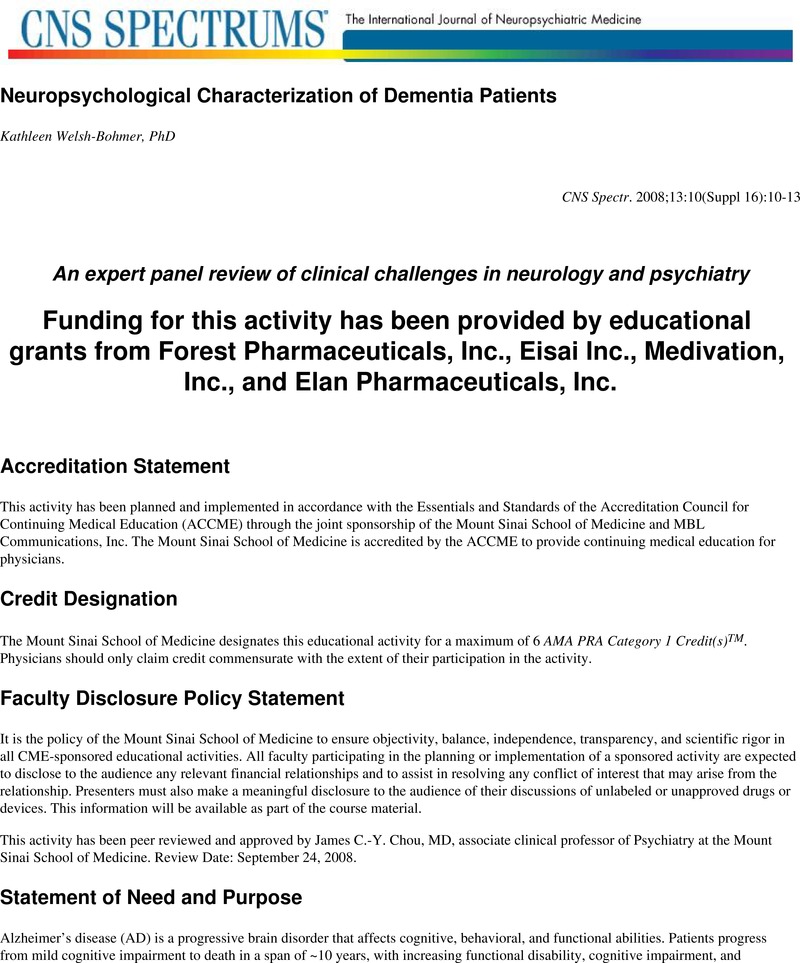No CrossRef data available.
Article contents
Neuropsychological Characterization of Dementia Patients
Published online by Cambridge University Press: 07 November 2014
Abstract
An abstract is not available for this content so a preview has been provided. Please use the Get access link above for information on how to access this content.

- Type
- Research Article
- Information
- Copyright
- Copyright © Cambridge University Press 2008
References
1.Park, DC, Lautenschlager, G, Hedden, T, Davidson, NS, Smith, AD, Smith, PK. Models of visuospatial and verbal memory across the adult life span. Psychol Aging. 2002;17(2):299–320.Google Scholar
2.Schmitz-Scherzer, R, Thomae, H. Constancy and change of behavior in old age: Findings from the Bonn Longitudinal Study on Aging. In: Schaie, KW, ed. Longitudinal Studies of Adult Psychological Development. New York, NY: Guilford Press; 1983:191–221.Google Scholar
3.Siegler, IC. Psychological aspects of the Duke longitudinal studies. In: Schaie, KW, ed. Longitudinal Studies of Adult Psychological Development. New York, NY: Guilford Press; 1983:136–190.Google Scholar
4.Schaie, KW, Willis, SL. Age difference patterns of psychometric intelligence in adulthood: generalizability within and across ability domains. Psychol Aging. 1993;8(1):44–55.CrossRefGoogle ScholarPubMed
5.Schaie, KW. The impact of longitudinal studies on understanding development from young adulthood to old age. Int J Behav Dev. 2000;24(3):257–266.CrossRefGoogle Scholar
6.Welsh, KA, Butters, N, Hughes, JP, Mohs, RC, Heyman, A. Detection and staging of dementia in Alzheimer’s disease. Use of the neuropsychological measures developed for the Consortium to Establish a Registry for Alzheimer’s Disease. Arch Neurol. 1992;49(5):448–452.CrossRefGoogle ScholarPubMed
7.Bäckman, L, Jones, S, Berger, AK, Laukka, EJ, Small, BJ. Cognitive impairment in preclinical Alzheimer’s disease: a meta-analysis. Neuropsychology. 2005;19(4):520–531.CrossRefGoogle ScholarPubMed
8.Hayden, KM, Warren, LH, Pieper, CF, et al.Identification of AD and VAD prodromes: The Cache County Study. Alzheimers Dement. 2005;1:19–29.CrossRefGoogle ScholarPubMed
9.Petersen, RC, Smith, GE, Waring, SC, Ivnik, RJ, Tangalos, EG, Kokmen, E. Mild cognitive impairment: clinical characterization and outcome. Arch Neurol. 1999;56(3):303–308.CrossRefGoogle ScholarPubMed
10.Marson, DC, Ingram, KK, Cody, HA, Harrell, LE. Assessing the competency of patients with AD under different legal standards. Arch Neurol. 1999;52(10):949–954.CrossRefGoogle Scholar
11.Unverzagt, FW, Kasten, L, Johnson, KE, et al.Effect of memory impairment on training outcomes in ACTIVE. J Int Neuropsychol Soc. 2007;13(6):953–960.Google Scholar




